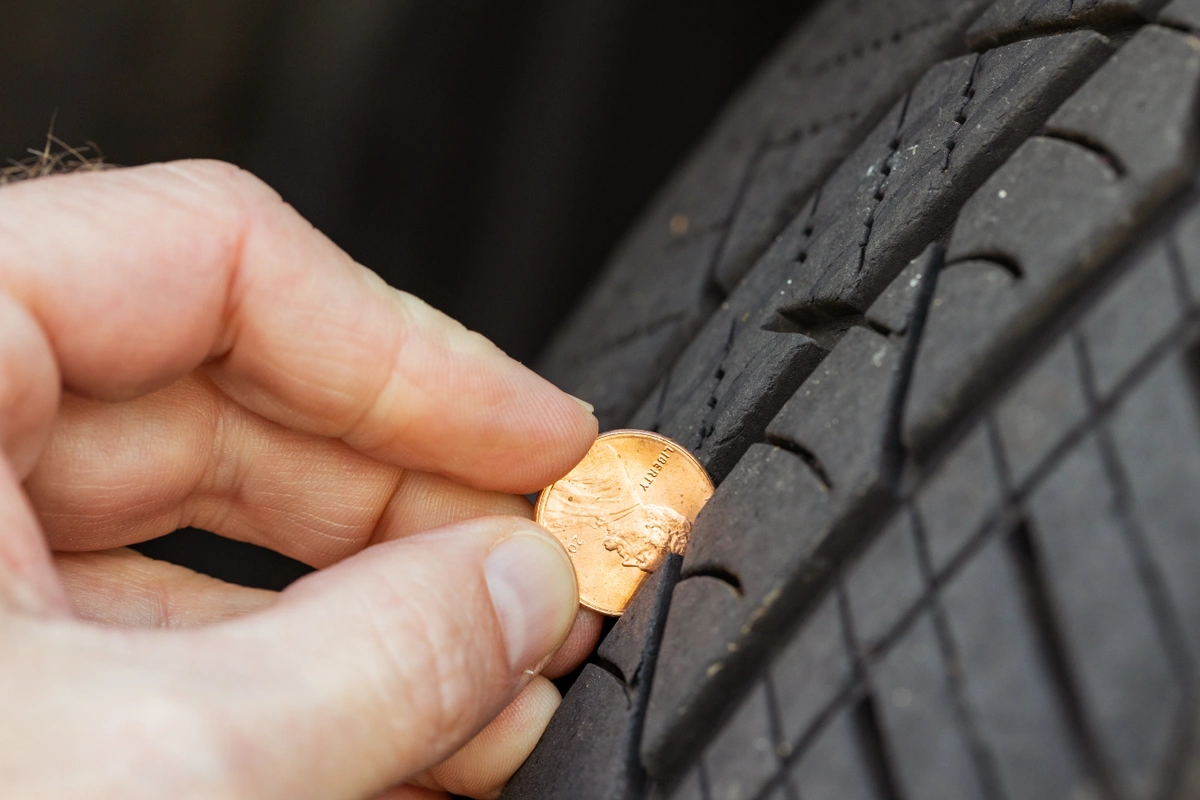Car tires should be changed when the tread depth falls below 2/32 inches or they show signs of severe wear and damage. Regular tire inspections and maintenance are crucial for ensuring that your car’s tires are in good condition.
Tires are the only part of a car that actually touches the road, so keeping an eye on their condition is vital if you want to be safe while driving. The way your car handles, brakes, and stays stable can all be influenced by the state of your tires.
Of course, they’re going to wear out eventually due to normal use, but it’s also important to factor in road conditions, how you drive, and what kind of climate you live in. There are simple ways you can regularly check your tread depth using basic household items like a penny.
Other signs that it might be time to replace your tires include visible signs of wear on the tread indicators or sidewalls of the tire. Look out for things like cracks forming or bulges too.
Taking care of your tires will extend their life and keep everyone safe from hazards caused by old ones.

Signs It’s Time To Change Your Car Tires
It’s essential to inspect car tires regularly for signs of wear. Uneven tread wear is a key indicator that tires may need replacement. This occurs when parts of the tire tread are worn down more than others. Use the penny test to check. Put a penny into the tread with Lincoln’s head down. If you see his head fully, the tread is too shallow.
Look out for bulges or cracks in the sidewall. These flaws can cause sudden tire failure. Cracks signify the rubber is breaking down. Bulges indicate weakened internal structure, often from hitting a pothole or curb. Spotting these issues means immediate tire change is necessary to ensure safety.
Factors That Affect Tire Lifespan
Your driving habits greatly influence tire wear. Frequent, abrupt stops and heavy acceleration can shorten tire life. Regularly driving over long distances, especially at high speeds, may also accelerate wear.
Road conditions play a significant role in tire longevity. Potholes, uneven roads, and rough terrain can cause irregular wear and damage. This means tires may need changing sooner.
Tires are also affected by the climate. In places with extreme temperatures, tires can degrade faster. Hot climates can increase the breakdown of tire materials, while cold climates can cause them to harden and lose traction.
How To Check The Tread Depth
Checking tread depth is important for safety. Use a penny to easily check. Place a penny into the tire tread with Lincoln’s head upside down. If all of Lincoln’s head is visible, your treads are too shallow and tire replacement may be necessary.
A tread depth gauge gives a more precise measurement. Simply insert the gauge into the tread groove. Read the measurement. If it’s less than 2/32 of an inch, you need new tires. Always ensure consistent depth across the tire’s surface.

When To Replace Based On Tread Depth
Changing car tires is crucial for safety. The minimum legal tread depth is 2/32 of an inch. Driving on tires with less can be unsafe.
To maintain optimal performance, change tires before they reach the legal limit. Tires with a tread depth of 4/32 of an inch or less can put you at risk, especially in wet conditions. For best grip and water evacuation, keep an eye on tread wear. Always opt for new tires to ensure your vehicle handles safely.
Other Important Considerations
Car tires have an expiration date even if they look good. You should check the tire manufacture date, often found on the sidewall. Tire aging can lead to failure, and experts typically suggest replacement at 5-6 years regardless of tread depth.
Unusual vibrations or noise when driving can suggest tire issues. It could mean internal damage, improper balance, or misalignment. These signs should not be ignored as they can result in unsafe driving conditions. Visit a technician if you notice these issues.

Frequently Asked Questions About Car Tires Changing
How Do I Know When My Tires Need Replacing?
Replace your tires if Lincoln’s head is visible in the tread. Check for cracks, bulges, and cuts. Replace tires if tread wear indicators are flush with the tread.
When Should You Change All 4 Tires?
If all four tires show uneven wear, deep wear indicators, visible damage, or after five years, change them all.
How Long Should Car Tires Last?
Tires typically last between 25,000 and 50,000 miles, depending on driving habits.
How Many Miles Can You Go Before Changing Tires?
Tires need to be replaced every 25,000 to 50,000 miles, depending on the manufacturer.
In conclusion
Make sure you maintain your tires to stay safe. Remember to check your tires’ condition. Your travels will be smoother with regular checks. Make sure you time your tire change right.
With the right tires beneath your car, you’ll go farther.

